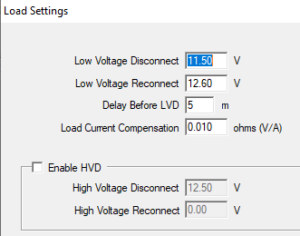The two main factors that affect the accuracy of SOC with LVD/LVR settings are the discharge rate and battery cell temperature.
Battery voltage can most accurately indicate SOC with an open circuit battery. This is commonly referred to as rest voltage. The battery voltage rises above rest voltage during charging and drops below rest voltage during discharging. The greater the discharge current is, the more the voltage will drop below the rest voltage. In addition, when there is a very low SOC (< ~10%) a discharge current will have even more effect on the battery voltage. The impact of charge and discharge current on voltage is also greater with older batteries that are reaching the end of life.
Since the battery voltage will be pulled lower with higher discharge rates, the voltage will reach the LVD voltage sooner with larger loads. Conversely, the load would disconnect with a higher SOC when there are smaller loads.
Off-grid systems typically do not have high discharge rates. This would be for systems with continuous loads such as telecom and systems designed with larger battery banks that have more days of autonomy. The voltage of these systems will not be affected by the load current much and the voltage drop below rest voltage will be minimal. For example, discharge rates of < C/100 with lead-acid batteries will likely lower the voltage by < 0.1V below rest voltage for a 12V battery.
To account for higher load currents that do cause more impactful voltage drops, Morningstar provides a Load Current Compensation (LCC) setting. This is provided in the load control settings of the setup Wizards in MSView.

It is important to not set the LCC too high or it can overcompensate and disconnect the battery at too low a voltage in relation to the SOC. LCC settings are inversely proportional to the Ah rating of the battery bank. Therefore, the LCC setting for larger battery banks should be lower than with smaller battery banks in order not to overcompensate for current. This is because the discharge rate corresponds to higher current levels with higher Ah battery banks. A C/20 discharge rate with a 100Ah battery would be 5A while a C/20 discharge rate of a 500Ah battery would be 25A.
The LLC is also directly proportional to the nominal voltage of the battery. Higher voltages means higher current compensation of the LVD. We recommend the following calculations to determine the settings for LCC.
Lead Acid Batteries
LCC @12V = (-0.8 / battery Ah) ohms (V/A)
LCC @24V = (-1.6 / battery Ah) ohms (V/A)
LCC @48V = (-3.2 / Battery Ah) ohms (V/A)
Lithium batteries have a more stable voltage in relation to charge and discharge currents. Therefore, the LCC settings for Lithium batteries should be set considerably lower than for Lead Acid batteries.
Lithium (LiFePO4) Batteries
LCC @12V = (-0.32 / battery Ah) ohms (V/A)
LCC @24V = (-0.64 / battery Ah) ohms (V/A)
LCC @48V = (-1.28 / Battery Ah) ohms (V/A)
The effect of charge and discharge current on voltage increases with colder battery cell temperatures. Therefore, high discharge currents during cold temperatures will cause an LVD disconnect at a higher SOC than it would in warmer conditions. Unlike charge settings that use temperature compensation to increase the regulation voltages there is no temperature compensation used with load control.
Since the freezing point of lead-acid batteries increases the lower the SOC is, it is somewhat reassuring to know that the load may disconnect the battery sooner when it is cold and potentially keep the battery from freezing as easily in very cold environments. However, this will only happen when there is a high discharge current so it is still important to set LVD higher for very cold environments.

